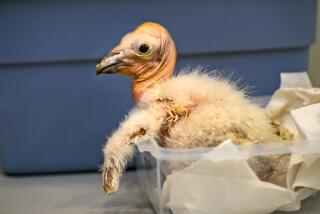Colombia condor conservation program lacks hard numbers
Their wings spanning 10 feet or more as they glide serenely above Colombia’s Andes, condors are majestic physical specimens. They have been important symbols here since pre-colonial times, when indigenous tribes saw them as messengers of the gods and harbingers of good fortune.
Essentially an oversized vulture, condors are national symbols in Colombia and also Ecuador, Peru, Bolivia, Chile and Argentina, largely because of the mystical importance attached to them by South American native populations.
Less known here, but increasingly important, is the role they play in the environment.
“The singularity of condors as a species has much to do with their size, that they live for up to 70 years and because they symbolize the Andes, nesting in altitudes of 12,000 feet or more,” said Fausto Saenz, a 34-year-old biologist who soon will earn the first doctorate awarded in condor ecology at a Bogota university. “But they also keep the ecology clean.”
Like their relatives in California, condor populations in Colombia have been decimated in recent decades. The birds have fallen victim to high voltage power lines, makers of homeopathic medicines and misguided farmers and peasants who poison or shoot them, thinking the birds prey on live animals. (In fact, condors eat only carrion.)
Their declining numbers prompted the San Diego Zoo in 1989 to begin a program of releasing U.S.-bred condors in the Colombian wild to keep the birds from becoming extinct. Working with Colombian biologists, the zoo so far has released 71 condors in seven paramos, the high altitude Andean ecosystems that are the birds’ natural habitat.
The condor program, which is one of the San Diego Zoo’s signature conservation efforts and part of its mission to support endangered species in far-flung regions of the world, has been applauded here for focusing attention on a unique and threatened species.
But there’s a problem from a research standpoint: No one knows how many of the 71 transplanted birds have survived, where exactly they nest or fly, or how many offspring they have produced — all key metrics needed to assess the success of the repopulation campaign.
Up to now, condors have been released with radio telemetry emitters that have a limited range and whose batteries last only a year. Their usefulness depended on human monitors on the ground who scan the skies for a signal.
Now officials in both countries want to address the data gap with a new cellphone-based monitoring system. Using implanted beeper chips that emit GPS-based data that is downloaded via cellphone towers, the system can accurately pinpoint a bird’s location every 15 seconds.
“This will allow us to track condors efficiently and over a longer term,” said Saenz. The system is similar to a satellite-based system used to track about half of the 230 condors that the San Diego Zoo has released into the wild in California, Arizona, New Mexico and Baja California, said Michael Mace, curator of birds.
It’s part of what Mace describes as an “enhancement” of the condor release program that will also include transferring some of the condor breeding capacity to as many as four Colombian zoos. Currently all the condors released here are hatched by some 20 breeding pairs in 17 U.S. zoos, including San Diego.
“We’re working with Colombian officials to try to mirror the model that’s worked so successfully with California condors,” Mace said, adding that the San Diego Zoo will continue to provide the hardware used to track the giant birds.
It’s up to the Colombians to pay for monitoring, including the costly process of downloading and analyzing the data, and sending people out into remote areas to retrieve it. Colombia still hasn’t come up with funding, which can run to several thousand dollars per bird per year.
The Colombian Zoo Assn., the Environment Ministry and the national parks system are reviewing the entire condor release program with the aim of transferring more operations here. But it’s not going to be cheap. The mating programs are expensive, Mace said, with condor enclosures costing at least $100,000 to build.
A key unknown is whether released condors are reproducing. Saenz said they have produced at least two chicks, one of which is known to have died. The status of any others is a mystery, said Alan Lieberman, a retired San Diego Zoo official who played a key role in starting up the Colombia condor release program.
“We know from anecdotal evidence there have been offspring in the Purace and Chingaza paramos where birds were released, we just don’t know how many have survived,” Lieberman said. “It’s a fairly difficult task to track them because it requires people on the ground and these areas are so remote.”
Saenz said there is encouraging anecdotal evidence that suggests condors are making something of a comeback — a group of 18 apparently native condors was recently spotted in the Almorzadero paramo in northeastern Colombia, an area they were not previously known to inhabit.
But the evidence is purely anecdotal. Without an efficient tracking system, Saenz said, the origin of the condors there can only be guessed at.
Special correspondent Kraul is based in Bogota.
More to Read
Sign up for Essential California
The most important California stories and recommendations in your inbox every morning.
You may occasionally receive promotional content from the Los Angeles Times.










